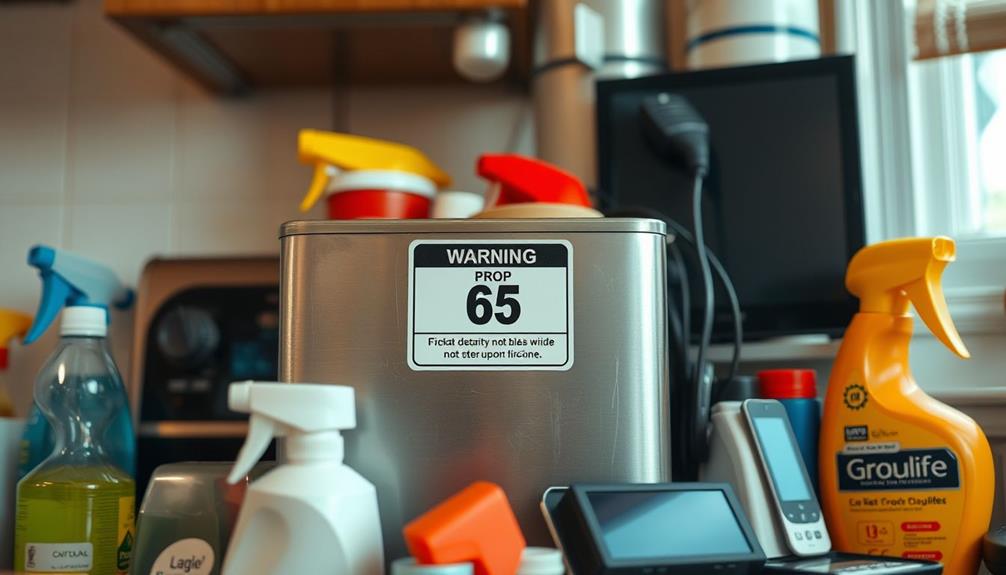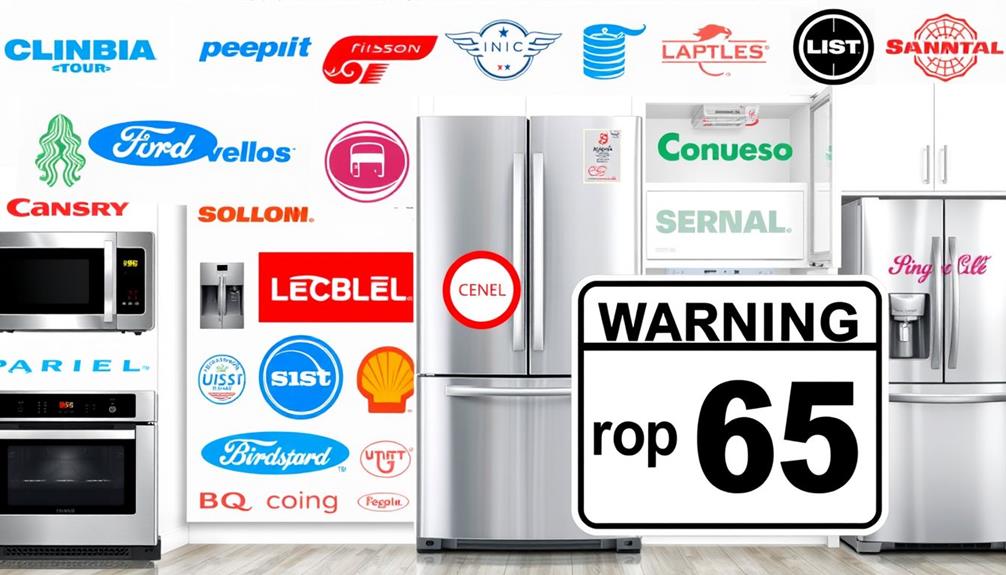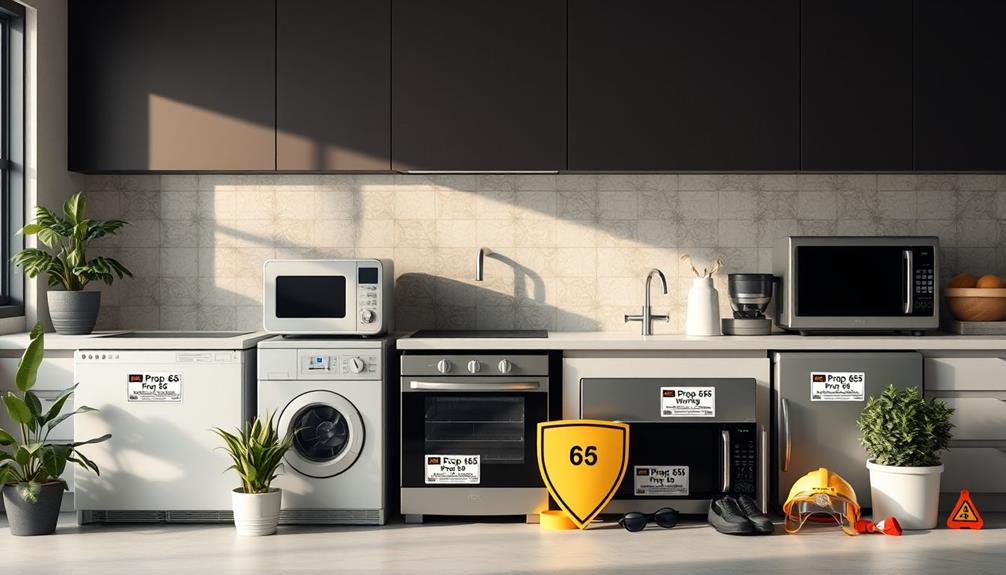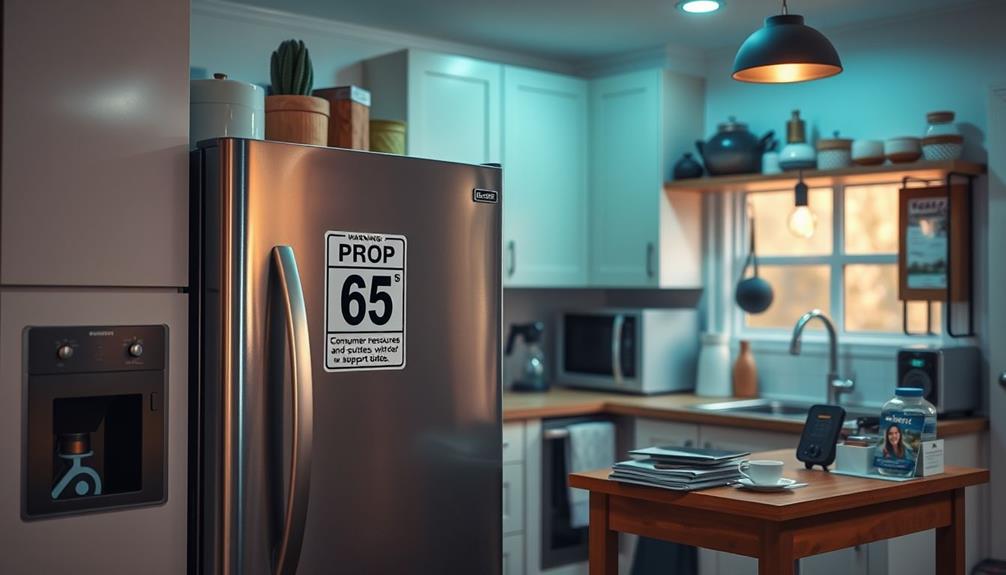California's Prop 65 mandates that manufacturers warn you if their appliances contain chemicals that could harm your health. With over 900 listed substances, these warnings help you make informed choices about what's in your home. Common chemicals you might encounter include phthalates, BPA, and flame retardants, often found in plastic parts and insulation. While normal use typically poses minimal risk, staying aware is essential for your safety. Regular maintenance and proper ventilation can further reduce any potential exposure. If you're curious about specific precautions and brands, there's more to uncover that can help you navigate these warnings effectively.
Key Takeaways
- Proposition 65 requires warning labels on products containing significant levels of harmful chemicals, informing consumers about potential risks.
- Common chemicals in appliances include phthalates, BPA, and flame retardants, which can pose health risks like endocrine disruption and reproductive harm.
- Proper maintenance and ventilation of gas appliances are essential to minimize exposure to harmful emissions and ensure safety.
- Major appliance brands often display Prop 65 warnings, indicating potential chemical exposure; brands without warnings may have lower chemical levels.
- Consumers can utilize resources from OEHHA and community groups to better understand chemical risks and safe appliance use and disposal.
Overview of Proposition 65
Proposition 65, also known as the Safe Drinking Water and Toxic Enforcement Act of 1986, aims to protect Californians from harmful chemical exposures. Under this California law, businesses are required to provide warning labels on products that may expose consumers to significant levels of listed chemicals known to cause cancer, birth defects, or reproductive harm.
As of 2025, over 900 chemicals are included on the Proposition 65 list, with updates made annually by the Office of Environmental Health Hazard Assessment (OEHHA). Understanding the importance of holistic lifestyle approaches can help mitigate some health risks associated with chemical exposures.
These warning labels don't mean that products are inherently dangerous; many chemicals have been used safely for years with minimal risk of exposure. Instead, the law focuses on ensuring that you're informed about potential risks.
When you see a Proposition 65 warning, it indicates that the product contains listed chemicals, allowing you to make better decisions regarding your consumer exposure. The clarity of these warnings is essential, as they must clearly state both the presence of these chemicals and the associated risks.
Common Chemicals in Appliances

When using household appliances, you might encounter warnings related to common chemicals like phthalates and BPA. These substances, often found in flexible vinyl and plastics, raise concerns about potential health risks.
Furthermore, appliances can also consume energy even when not in use, contributing to higher utility bills, which can be mitigated through awareness of energy consumption patterns.
Additionally, flame retardants present in various components can contribute to hazardous exposure, making it important to understand what's in your appliances.
Phthalates in Household Appliances
Household appliances often contain phthalates, a group of chemicals that enhance the flexibility and durability of materials like vinyl and rubber. You might find these chemicals in the electrical wiring insulation and flexible plastic components of your washing machines, refrigerators, and dishwashers.
Dog health and nutrition is also affected by environmental factors, and while phthalates improve performance, they're listed under California's Proposition 65 due to their potential to disrupt endocrine function and cause reproductive harm.
To help you stay informed, here are some key points about phthalates in household appliances:
- Phthalates are often present in dust and can be inhaled or absorbed through skin contact.
- Poorly ventilated spaces increase the exposure risk to these chemicals.
- You're more likely to encounter phthalates in older appliances, which may not meet current safety standards.
- Manufacturers must provide Proposition 65 warnings if exposure levels exceed safe thresholds.
- Staying aware of these warnings can help you make informed decisions about your appliances.
BPA Presence in Plastics
In recent years, concerns over the presence of Bisphenol A (BPA) in plastics have intensified, especially regarding its use in household appliances like toaster ovens and microwaves. BPA is commonly found in epoxy and polycarbonate plastics used in these devices, raising alarms about potential exposure.
Classified as an endocrine disruptor, BPA can interfere with your hormonal functions, which is why many consumers are wary of products containing this chemical. Additionally, understanding the risks involved with various materials is essential for informed purchasing decisions. As of 2025, BPA remains on California's Proposition 65 list, meaning that products containing BPA sold in the state must carry a warning label.
Many major appliance brands, even those noted for their Prop 65 warnings, still use BPA in various plastic components. This situation poses a dilemma for consumers who want to avoid harmful chemicals known to the State.
In response to growing consumer demand for safer products, manufacturers are increasingly seeking BPA-free alternatives. These newer appliances often utilize BPA-free plastic options that can mitigate the risks associated with BPA exposure while still maintaining functionality.
Flame Retardants and Risks
While many consumers appreciate the safety features of household appliances, they may not realize that flame retardants used in these products can pose significant health risks. Flame retardants, such as polybrominated diphenyl ethers (PBDEs) and tris(1,3-dichloro-2-propyl) phosphate (TDCPP), are common in appliances like washing machines and refrigerators.
These chemicals can leach into dust and contribute to several health concerns, as highlighted by Proposition 65 warnings. Understanding the potential for high returns versus market volatility in other investment strategies can also help consumers make informed choices regarding overall safety.
Consider these potential risks:
- Reproductive harm
- Endocrine disruption
- Neurodevelopmental issues in children
- Increased cancer risk
- Long-term chemical exposures
The health hazard assessments associated with these flame retardants reveal alarming connections to serious illnesses.
Regular cleaning practices, such as using HEPA-filter vacuums and damp cloths, can help reduce dust accumulation, minimizing your exposure to these harmful chemicals. By understanding the implications of flame retardants in your appliances, you can make informed choices to protect your health and that of your family.
Always pay attention to Proposition 65 warnings and take proactive steps to mitigate any potential risks.
Sources of Chemical Exposure

Understanding the sources of chemical exposure in your home is vital for maintaining a safe environment. Many appliances can emit hazardous substances, including those listed under Prop 65 warnings.
For example, natural gas appliances may release byproducts like benzene, carbon monoxide, and formaldehyde during combustion, which can impact your health and gout management strategies if not properly managed. These chemicals are a concern, especially if you use gas-powered appliances regularly.
Plastic components in your appliances often contain phthalates and flame retardants, which are also on the Prop 65 list. Although enclosed components like circuit boards may harbor these chemicals, normal use typically results in negligible exposure for you.
However, it's still important to be aware of these potential risks. To further minimize your risk of chemical exposures, regular maintenance and proper installation of appliances are key.
Verify that your gas appliances are well-ventilated and regularly inspected for leaks to help reduce the presence of hazardous substances in your home. By being proactive and informed about these sources of chemical exposure, you can create a safer living environment for you and your family.
Reducing Exposure Risks

To reduce exposure risks, make certain all your appliances are properly maintained and installed.
Regular maintenance guarantees peak performance and longevity of devices, including effective air purification systems that can help improve indoor air quality.
When using gas units, always follow ventilation guidelines to keep harmful gases at bay.
Regular checks for leaks and using exhaust fans can help create a safer environment in your home.
Proper Appliance Maintenance
Proper appliance maintenance is essential for keeping your home safe from harmful chemicals and guaranteeing efficient operation.
By regularly inspecting and maintaining your appliances, you can minimize risks of chemical exposure from malfunctioning components. Additionally, consider utilizing a home cleaning service to help maintain a clean environment, which can further reduce exposure to harmful substances.
Here are some important practices to follow:
- Guarantee proper ventilation in areas with gas or propane appliances to avoid harmful gas buildup.
- Use exhaust fans or range hoods vented outside when cooking to eliminate indoor air pollution.
- Test and maintain carbon monoxide alarms in your home for early detection of dangerous gas leaks.
- Clean filters in appliances like dehumidifiers and air purifiers regularly to prevent dust and chemical residue buildup.
- Familiarize yourself with the manufacturer's guidelines for each appliance to guarantee safe operation.
Effective Ventilation Practices
Maintaining your appliances is just the beginning of guaranteeing a safe home environment; effective ventilation practices play a key role in reducing exposure to harmful emissions.
When using gas or propane appliances, proper ventilation is vital to prevent the buildup of indoor air pollutants like carbon monoxide and formaldehyde. By utilizing exhaust fans or range hoods vented to the outside while cooking, you can greatly improve air quality and minimize risks.
Regular maintenance checks on your gas-powered appliances are essential. Confirm they're functioning correctly and inspect for leaks to reduce the chance of toxic gas exposure.
Installing carbon monoxide alarms and routinely testing them can alert you to dangerous levels of this harmful gas before they reach critical concentrations.
Additionally, make certain your living spaces are well-ventilated during appliance use, especially in enclosed areas. This helps dilute and disperse any potential hazardous emissions effectively.
Safe Appliance Disposal

Responsible disposal of appliances is essential for protecting the environment and public health. Improper disposal can lead to the release of harmful substances, similar to the challenges faced with geothermal energy in North Carolina, where awareness and education are vital for sustainable practices.
When you're ready to get rid of an old appliance, make sure to follow proper disposal methods to prevent hazardous materials from harming our planet. Here are some tips for safe appliance disposal:
- Check local regulations and programs for recycling options.
- Take e-waste, like microwaves and refrigerators, to designated recycling facilities.
- Utilize haul-away services offered by many retailers when buying new appliances.
- Never disassemble, burn, or abandon appliances, as these actions can release toxic chemicals.
- Contact manufacturers for guidance on appliances with Prop 65 warnings.
Brands With Prop 65 Warnings

When shopping for appliances, you might notice many brands display Proposition 65 warnings, signaling potential exposure to harmful chemicals. These warnings are common among major brands like Maytag, Whirlpool, Samsung, and GE, as they often indicate the presence of listed chemicals such as phthalates and BPA in their household appliances.
This awareness parallels the growing trend of converting traditional retirement accounts to Gold IRAs, which offers investment strategies that emphasize diversification and safety. Specific products, including washing machines and refrigerators from Frigidaire and LG, also carry these warnings, highlighting concerns over significant chemical exposures.
Additionally, everyday kitchen appliances like microwaves and toaster ovens from brands such as Magic Chef and Black+Decker feature Prop 65 warnings, which raise awareness of potential chemical exposures that could impact reproductive health.
Even products like dishwashers and dehumidifiers from Honeywell and Keystone come with these warning labels due to toxic chemicals.
On the other hand, some brands, like Miele and Panasonic, have managed to avoid displaying Prop 65 warnings, suggesting their products may not contain significant levels of listed chemicals.
Understanding which brands carry these warnings can help you make informed choices while shopping for appliances in California, prioritizing your health and safety.
Strategies for Minimizing Risks

Exposure to harmful chemicals can be a concern when using appliances that carry Prop 65 warnings. To minimize your risks and guarantee a safer home environment, consider implementing these strategies:
- Regularly clean your living spaces using wet mops and HEPA filter vacuums to reduce dust accumulation, which may contain harmful chemicals.
- Guarantee proper ventilation when using gas-powered appliances to minimize exposure to emissions like carbon monoxide and formaldehyde.
- Practice good hygiene practices by frequently washing your hands, especially before food preparation and eating, to prevent ingesting dust that could harbor toxic chemical residues.
- Follow manufacturer guidelines for the installation and maintenance of all appliances. This helps guarantee they operate safely and efficiently, thereby reducing the risk of chemical exposure.
- Educate your household members about the importance of keeping living spaces clean and the dangers of chemical exposure associated with Prop 65 warnings.
Consumer Resources and Support

Maneuvering California's Proposition 65 can feel overwhelming, but numerous resources are available to support consumers. The official OEHHA website provides detailed information on listed chemicals, current health risk levels, and guidance for interpreting warning labels.
This is your go-to source for understanding chemical exposures and identifying safe harbor levels for various substances in household appliances.
If you're concerned about specific products, consider utilizing third-party testing services. These organizations can help you determine whether your household appliances contain any Proposition 65 chemicals, offering additional peace of mind.
Community advocacy groups focused on environmental health also play an essential role, providing support and information on reducing exposure to harmful chemicals while promoting safer alternatives.
It's beneficial to engage directly with manufacturers, too. Don't hesitate to ask them about their safety standards and chemical contents; most companies appreciate consumer inquiries and can clarify any concerns.
Frequently Asked Questions
Why Do Appliances Have Prop 65 Warnings?
Appliances have Prop 65 warnings because they might expose you to chemicals linked to serious health risks. Manufacturers label these products to help you make informed choices about potential hazards in your home environment.
Should I Worry if a Product Has a P65 Warning?
You shouldn't panic if a product has a P65 warning. It just means there are chemicals present, but often in negligible amounts. Research specific products to understand the actual risks and make informed choices.
Why Do Toasters Have Prop 65 Warnings?
Toasters have Prop 65 warnings because they might contain chemicals like phthalates, BPA, or emit trace formaldehyde when heated. These warnings inform you about potential health risks, even if actual exposure levels are low.
Why Does My Dishwasher Have a P65 Warning?
Isn't it fascinating that your dishwasher, designed to clean, might actually warn you about chemicals? It likely has a Prop 65 warning due to components that could expose you to harmful substances during use.
Conclusion
In traversing California's Prop 65 warnings, you're not just reading labels; you're becoming an informed consumer armed with knowledge. By understanding the common chemicals in appliances and taking steps to reduce exposure, you can protect yourself and your family. Remember, knowledge is your best shield against potential risks. So, don't shy away from those warnings—embrace them as opportunities to make safer choices and contribute to a healthier home environment. Your vigilance can turn caution into empowerment.










